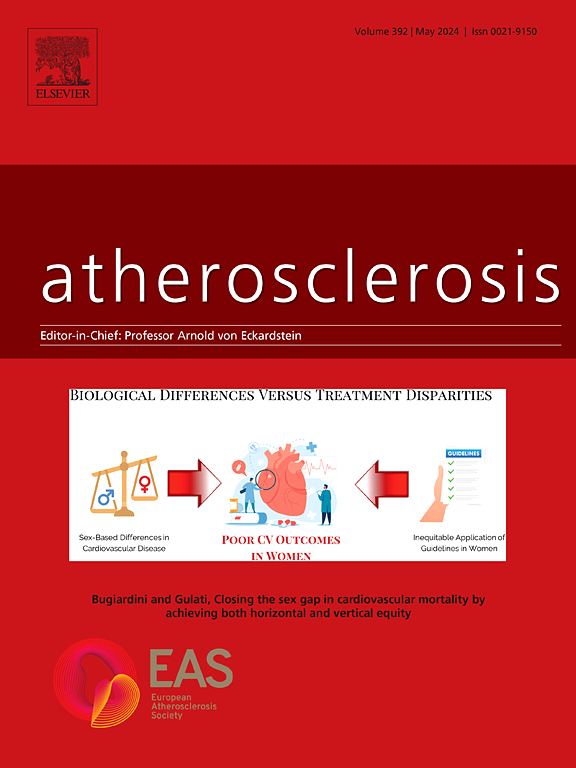Genetically determined increase in apolipoprotein C-III (APOC3 gain-of-function) delays very low-density lipoprotein clearance in humans
IF 4.9
2区 医学
Q1 CARDIAC & CARDIOVASCULAR SYSTEMS
引用次数: 0
Abstract
Aim
Apolipoprotein C-III (apoC-III) is an important regulator of triglyceride (TG) metabolism and a target for intervention. The present study examined the effects of gain-of-function (GOF) variants in APOC3 on apolipoprotein B kinetics to understand further how changes in the synthesis of this apolipoprotein impact triglyceride-rich lipoprotein (TRL) metabolism.
Methods
Two groups of subjects were recruited by population screening, 9 carriers of known APOC3 GOF variants and 9 age-, sex- and BMI-matched non-carriers. The kinetics of TRL were determined using stable isotope tracers of apoprotein and triglyceride metabolism in a non-steady-state protocol involving administration of a fat-rich meal.
Results
APOC3 GOF carriers had 47 % higher plasma apoC-III levels compared to non-carriers (P = 0.022) and higher production rates for the apolipoprotein. Post-prandial response (total area-under-curve) for plasma TG was 108 % greater in GOF carriers compared to non-carriers (P = 0.002) due specifically to higher levels of VLDL1. In contrast, no difference was seen in the chylomicron apoB48 response. Comparison of TRL kinetics between groups showed that APOC3 GOF carriers had lower fractional clearance rates for VLDL1-apoB100 and VLDL1-apoB48-containing particles (P < 0.02), but no difference in VLDL1-apoB100 or chylomicron apoB48 production rates. Both the rate of VLDL lipolysis and the rate of clearance of VLDL particles from the circulation were lower in APOC3 GOF carriers than in non-carriers. In contrast, chylomicron apoB clearance rates did not differ between APOC3 GOF carriers and non-carriers.
Conclusion
APOC3 GOF carriers showed specific alterations in TRL metabolism (compared to matched non-carriers), namely slower lipolysis and delayed clearance of VLDL1-sized particles, but no difference in chylomicron metabolism. Our findings suggest that intervention to reduce apoC-III production can be modelled as a reduction in TRL, particularly VLDL particle levels, without deleterious effects on fat absorption or hepatic VLDL production.

基因决定的载脂蛋白C-III (APOC3功能获得)的增加延迟了人类非常低密度脂蛋白的清除
脂蛋白C-III (apoC-III)是甘油三酯(TG)代谢的重要调节因子,也是干预的靶点。本研究检测了APOC3中功能获得(GOF)变异对载脂蛋白B动力学的影响,以进一步了解这种载脂蛋白合成的变化如何影响富甘油三酯脂蛋白(TRL)代谢。方法通过人群筛查招募两组受试者,9例已知APOC3 GOF变异携带者和9例年龄、性别和bmi匹配的非携带者。TRL的动力学是用载脂蛋白和甘油三酯代谢的稳定同位素示踪剂在非稳态方案中确定的,包括给予富含脂肪的膳食。结果apo3 GOF携带者血浆apoC-III水平比非携带者高47% (P = 0.022),载脂蛋白的生成率较高。GOF携带者的餐后血浆TG反应(曲线下总面积)比非携带者高108% (P = 0.002),特别是由于VLDL1水平较高。相比之下,乳糜微粒apoB48反应没有差异。各组间TRL动力学比较显示,APOC3 GOF携带者对含有VLDL1-apoB100和vldl1 - apob48的颗粒的分数清除率较低(P <;0.02),但VLDL1-apoB100和乳糜微粒apoB48的产率无差异。APOC3 GOF携带者的VLDL脂解率和VLDL颗粒从循环中的清除率均低于非携带者。相比之下,乳糜微粒载脂蛋白清除率在apo3gof携带者和非携带者之间没有差异。结论与配对的非携带者相比,apoc3 GOF携带者在TRL代谢方面表现出特异性改变,即脂解减慢和vldl1大小颗粒的清除延迟,但乳糜微粒代谢无差异。我们的研究结果表明,减少apoC-III产生的干预可以模拟为减少TRL,特别是VLDL颗粒水平,而不会对脂肪吸收或肝脏VLDL产生有害影响。
本文章由计算机程序翻译,如有差异,请以英文原文为准。
求助全文
约1分钟内获得全文
求助全文
来源期刊

Atherosclerosis
医学-外周血管病
CiteScore
9.80
自引率
3.80%
发文量
1269
审稿时长
36 days
期刊介绍:
Atherosclerosis has an open access mirror journal Atherosclerosis: X, sharing the same aims and scope, editorial team, submission system and rigorous peer review.
Atherosclerosis brings together, from all sources, papers concerned with investigation on atherosclerosis, its risk factors and clinical manifestations. Atherosclerosis covers basic and translational, clinical and population research approaches to arterial and vascular biology and disease, as well as their risk factors including: disturbances of lipid and lipoprotein metabolism, diabetes and hypertension, thrombosis, and inflammation. The Editors are interested in original or review papers dealing with the pathogenesis, environmental, genetic and epigenetic basis, diagnosis or treatment of atherosclerosis and related diseases as well as their risk factors.
 求助内容:
求助内容: 应助结果提醒方式:
应助结果提醒方式:


